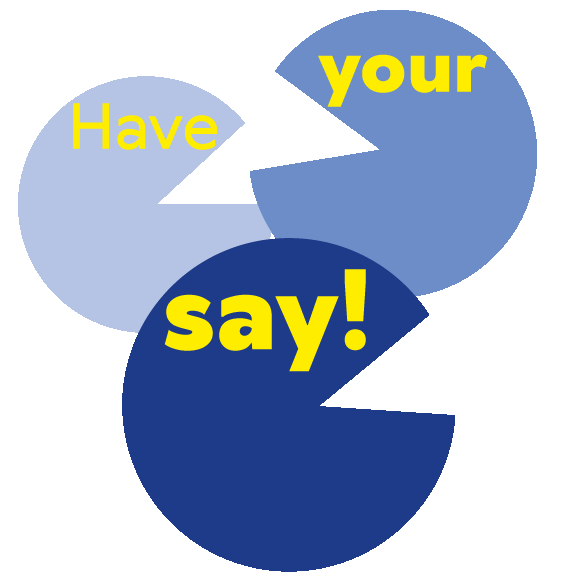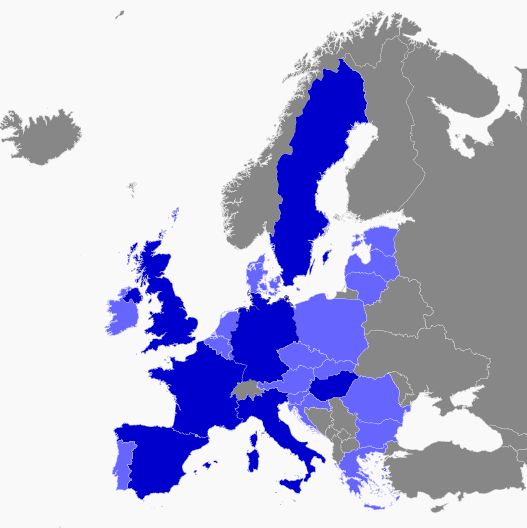The Easy Book about the EU is a teaching aid and textbook written in easy-to-read language, presenting the EU, why does it exist, what does it do, and how does it work. The book has been written as a teaching aid for all purposes, with special respect to those who are less trained in reading, and also those who are newcomers to a given language. Issued in 2022.
The book is available in several European languages: English, German, Hungarian, Italian, Swedish, Spanish and French.
See download links below.
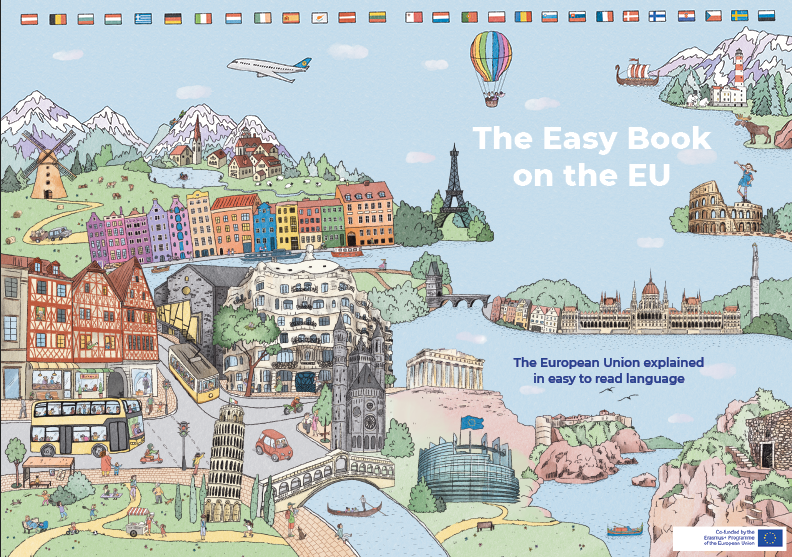 The book cover (back and front) presents a picture puzzle of EU countries' landmarks.
The book cover (back and front) presents a picture puzzle of EU countries' landmarks.
Introduction taken from the book:
What this book is about
In Europe, there is a very special community of countries. It is called the European Union, or short the EU.
The EU consists of 27 countries and the people of these countries. There are about 450 million people living in the European Union.
The countries have their independent governments.
Each country has its own rules and laws.
The laws that are created by each country’s government apply only to that country.
For example, the laws made in Germany only apply to people living in Germany. The laws issued in France apply only there and do not affect people in Spain, and the other way round.
The countries of the European Union have decided to take many decisions together und to unify their laws: one and the same rules should apply everywhere.
This has many advantages for all citizens, for example when they make holidays in another country, or when they buy and sell things across borders, or when they want to take a job in another country.
The European Union has been created in order to improve the lives of the citizens of its member countries. Not everybody always agrees with everything the European Union does. Still when critizing the European Union and what it does, it is best to know the facts.
This book has been written to give you an easy-to-understand source of information about what is the European Union, how it works and what it does.
This book gives information about
- The history of the EU
- What the EU does
- Important institutions in the EU
- Benefits and disadvantages of the EU
You can read the book from cover to cover. You can also start reading where there is something particularly interesting for you.
Happy reading!
Want to read this introduction in Hungarian? Here you are!
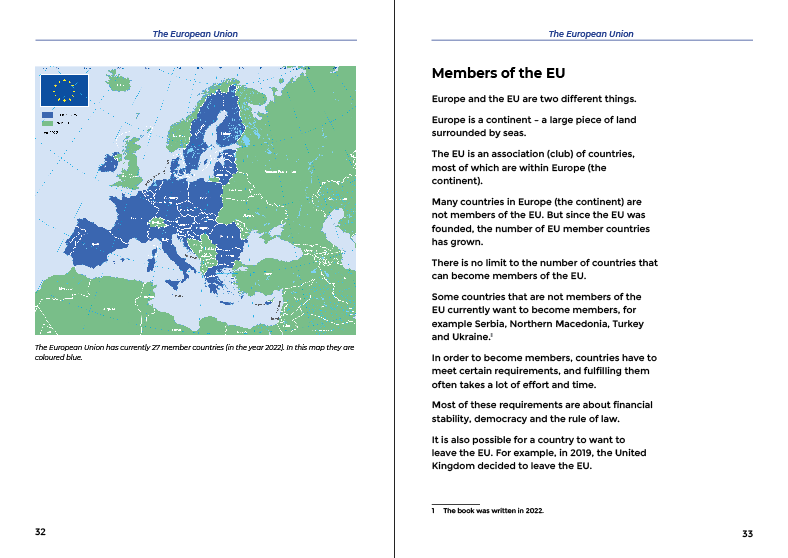 Pages from the book: chapter on how to become EU member state.
Pages from the book: chapter on how to become EU member state.
Download your copy of the book
This copies are in spread-view with 150 px resolution of pictures, chiefly meant for screen use.
We will provide high-resolution files (single page) for print later.
Hungarian edition (30 MB) - (Updated 2023-06-12)
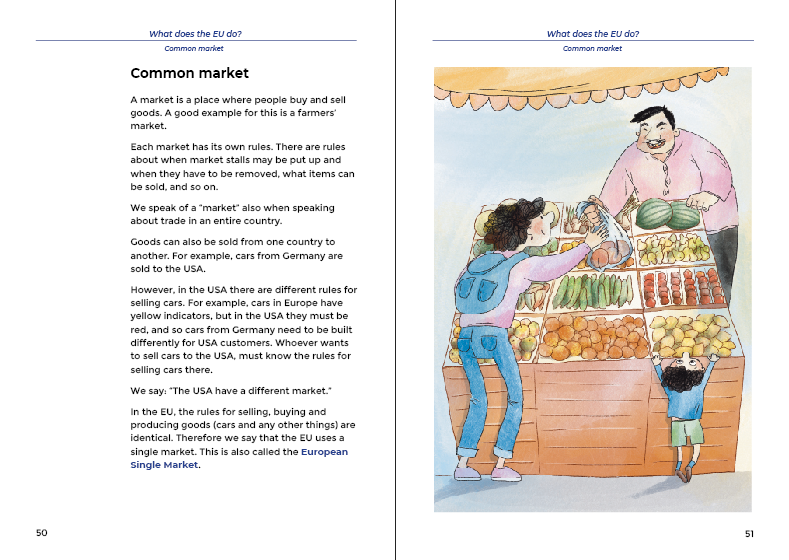 Pages from the book: chapter about the common market.
Pages from the book: chapter about the common market.
Chapter taken from the book:
Notes to the teacher
This book has been written to give information about the European Union (EU) – its history, its foundations, its values, its institutions, the way of its law-making, and generally what the EU means for the citizens of its member countries.
Who can benefit from reading this book?
We have written this book in very simple language so that it can be used by everybody including individuals with lesser command of the language. These can be people who are new to the country and the language, or people who have been facing obstacles at school.
Still we assume that the reader is interested in understanding some basic facts about the European Union.
This Book can be used by teachers in delivering seminars, lectures and tasks to their students. It can also be used by individuals to improve their familarity with the idea of the European Union, and key concepts and terminology to it.
The book may be used also a quick reference for looking up certain facts about the European Union, when in doubt.
For example, we use it in an educational Escape Room – a fun activity for everybody to learn something about the EU without even recognizing that there is an educational purpose – as an optional source for people to find out facts about the EU as they need it in the game.
The book is published in English, German, Spanish, French, Italian, Hungarian and Swedish.
Why do we think this book is useful?
The idea of the European Union has often been described as an idea that is difficult to grasp and articulate in a simple manner. This is necessarily so, as the European Union is a very complex thing. Also, from the perspective of most citizens, the EU’s institutions are mostly in foreign countries, people working in the EU usually use English or French as working language, and the procedures how the EU takes decisions and influences our everyday life are complicated. Hence the EU is a very abstract entity. People in their everyday life do often not see where the EU plays a role for them, or how they can play a role in the EU.
Moreover, there are a lot of false impressions about the EU out there, and in recent years false information about the EU has been distributed on porpuse by political actors who want to destroy the EU, or at least want to reduce its role in international or national politics and economy.
False information about the EU is an obstacle for citizens to take good decisions in elections. There is a lot of good information about the EU available in academic or other high-level language. What we found lacking is information on the EU accessible to really everybody.
Therefore, we saw the need of a source of information that gives reliable information on the EU in a language as easy to understand as possible.
Language used in this book
For the language used in this book we tried to follow principles of so-called plain language. Other terms are in use are easy language, simple language, et cetera. With respect to this book being issued in 7 European languages in parallel, we could not stick to one established model plain language. Concepts of plain language very much differ between national contexts. In some countries they are widely used (with the purpose to be inclusive). In other countries the idea has just begun sprouting. Hence what we did is, we tried to derive common rules from those plain language concepts we found available for various languages when we started working on the book in 2019/2020.
The process of writing this book
This book is one of the outcomes of the Have Your Say project – a three years co-operation of eight adult education organisations from seven European countries. The project was funded in 2019-2022 through the Erasmus+ programme of the European Union (as a “Strategic Partnership in Adult Education”). The project set out to develop new approaches to learning about the EU that should be both facts-oriented and entertaining. The book was to serve as a teaching aid to support the games and other learning activities. The book would give learners a source of information on the EU that is factually correct but easy to read.
For the contents of the book we took particular inspiration by a brochure published by Bundeszentrale fĂĽr politische Bildung (BPB, German Federal Center for Civic Education) in 2018 on occasion of the European Elections taking place that year.* The brochure was intended especially for readers with learning disabilities. It therefore uses highly simplified language along the principles of what is known, in German speaking countries, as Leichte Sprache. In practice we had found this brochure useful also for other audiences, e.g. for students in Second Chance classes where young adults can get a school-leaving certificate.
Starting from this model, after creating a first translation into English, we re-arranged and updated the contents according to the needs of our target public, and added topics we found missing. Various other publications on the EU issued by various organisations in various countries were also taken into consideration . The editing and authoring was done in English, the working language of the partnership, with contributions made by all partners. The final touch on the English text was provided by Joseph Karauli (West London Equality Council) and Christian Geiselmann (Volkshochschule Hannover). Partners then created the local language versions of this book based on the English.
Illustrations for this book were made by Kseniya Kochkina. She also drew the panorama picture for the cover pages.
-------
* Einfach Politik. Europa. Heft in einfacher Sprache. Available from BPB, www.bpb.de/shop, order number 9366. ISBN 978-3-8389-7176-6
Page 1 of 7

